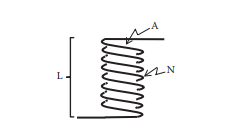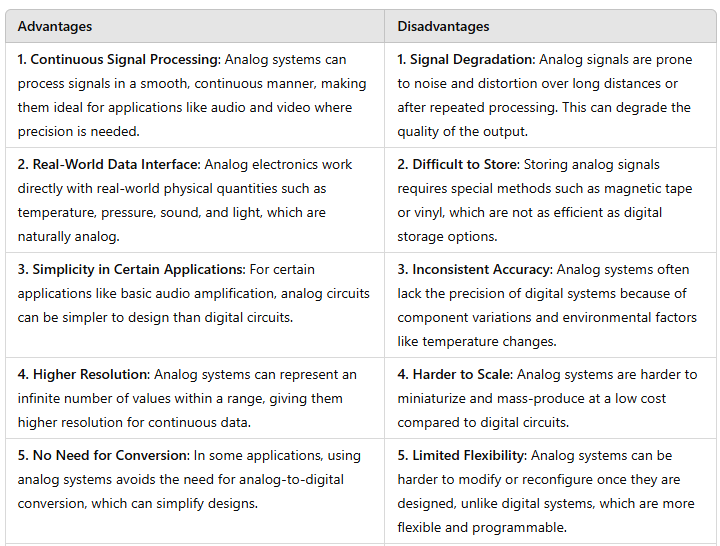Introduction:
The field of electronics is one of the great success stories of the 20th century. From the crude spark-gap transmitters and “cat’s-whisker” detectors at its beginning, the first half century brought an era of vacuum-tube electronics that developed considerable sophistication and found ready application in areas such as communications, navigation, instrumentation, control, and computation. The latter half century brought “solid-state” electronics – first as discrete transistors, then as magnificent arrays of them within “integrated circuits” (ICs) – in a flood of stunning advances that shows no sign of abating.
What Is Analog Electronics:
An electronic analog signal provides the variation of a quantity such as voltage or current, with time, in a continuous fashion. In an analog signal waveform there is no discontinuity of values and there is no abrupt or large variation from one value to the next. A digital waveform differs from an analog waveform in that the digital waveform has only well-defined steps values kept at different periods of time. The transition between the two steps is assumed to be instantaneous. Figure 1 shows a sample of an analog signal and a binary digital signal.

Analog Systems:
An electronic system is an assembly of electronic devices and components connected in order to respond to a defined input or inputs so as to produce the desired output or outputs. Electronic systems have characteristics that accept the input or inputs and manipulate them to create the desired output signal or signals. A good electronic system is one that has been designed to solve a particular problem in the most appropriate and efficient way.

In an electronic system, we normally sense the physical input quantity using some form of sensor, transducer, or actuator that generates an electrical signal correlated to the physical input. In the same way, in a system the output quantity is usually uninhibited by a sensor, transducer, actuator, or display that is controlled by the electronic output from the electronic system.
Semiconductor:
Any material can be classified according to its conductivity; there are conductor, insulator, and semiconductor materials. Semiconductor materials, as the name indicates, are materials in which conductivity is a great deal less than a conductor but is also substantially larger than an insulator.
Conductors: Conducts currents, Valence and conduction band overlap.
Insulators: Does not Conducts currents, Valence and conduction band separated by forbidden energy gap.
Semiconductor: Conductivity is less than conductor and greater than insulators.
Semiconductor type :
- Intrinsic: Pure form of semiconductor Conductivity is poor.
- Extrinsic: Impure form of semiconductor Conductivity is improved by adding impurity.
- N-type Semiconductor: Created by adding pentavalent impurity Eg. Arsenic or antimony.
- P-type Semiconductor: Created by adding trivalent impurity Eg. Boron or Gallium.
Doping: Adding external impurities to a semiconductor is known as doping a semiconductor. It was found that the addition of small amounts of impurities drastically changes its conductivity. Materials with impurities that produce an excess of electrons, in the conduction band, are n-type semiconductors.
P–N JUNCTION: When p-type and n-type materials are joined, a p–n junction is created. In practice, the junction is created together in the fabrication process.

Active And Passive Components:
The components used in electronic circuits may be classified into two categories namely active and passive components. Active components are those which can perform signal processing functions such as signal generation, rectification and amplification. These components basically are semiconductor diodes, transistors and SCR’s etc. Batteries and generators which supply energy, also fall in the category of active components. The passive components are those which can not by themselves perform the above mentioned functions. The basic passive components are resistors, inductors and capacitors.
Passive Components:
Resistor: The resistance is an electrical characteristic that describes how a component opposes the circulation of current. If the ratio of voltage to current provides a constant value then the passive component is known as a resistance or resistor. In a resistance, the relationship between voltage and current is defined in Ohm’s law.
Capacitance: A capacitor is a component that can store charges. The effect of storing charges in a capacitor makes the relationship between voltage and current more complicated and creates an electric field. A capacitor consists of two conducting surfaces separated by an insulating layer called a dielectric.
Inductor: An inductor is a coil of conducting material. In the simple form, an inductor can be illustrated as in Figure 3. A changing current in the conducting wire produces a changing magnetic field around the coil. This changing magnetic field induces an emf in the conductor within the field. Then when a current changes in a coil it induces an emf in the coil. This is known as self-inductance or commonly known as inductance. The voltage of the emf in the coil depends on the rate of change of the current with time

Active Components:
Diode: Diode is an electric device which allow current to flow only in one direction. The voltage applied to the semi conductor diode is referred to as bias voltage. The diode is the simplest and most fundamental non-linear circuit element Like a resistor, it has two terminals .Unlike a resistor, it has a non-linear current- voltage characteristics. Its use in rectifiers is the most common application.
Types Diode:
- Standard (Rectifier) Diode
- Zener Diode
- Light Emitting Diode (LED)
- Photodiode
- Schottky Diode
- Avalanche Diode
- Tunnel Diode
- Varactor Diode (Variable Capacitance Diode),
Transistor : Transistor is an electronic device made of three layers of semiconductor material that can act as an insulator and a conductor. The three layered transistor is also known as the bipolar junction transistor. Useful as a switch, but also as an amplifier.
Type Transistor:
- BJT – Bipolar Junction Transistor
- JFET – Junction Field Effect Transistor
- FET – Field Effect Transistor
- MOSFET (Metal-Oxide-Semiconductor Field-Effect Transistor
Op-amp: Operational amplifier or op-amp, is a very high gain differential amplifier with a high input impedance (typically a few meg-Ohms) and low output impedance (less than 100 Ω). Note the op-amp has two inputs and one output.
IC: Integrated Circuits are usually called ICs and popularly known as a silicon chip, computer chip or microchip. • Integrated Circuit, tiny electronic circuit used to perform a specific electronic function, such as amplification. It is usually combined with other components to form a more complex system.

Advantages And Disadvantages of Analog Electronics:


Various Applications of Analog Electronics:











